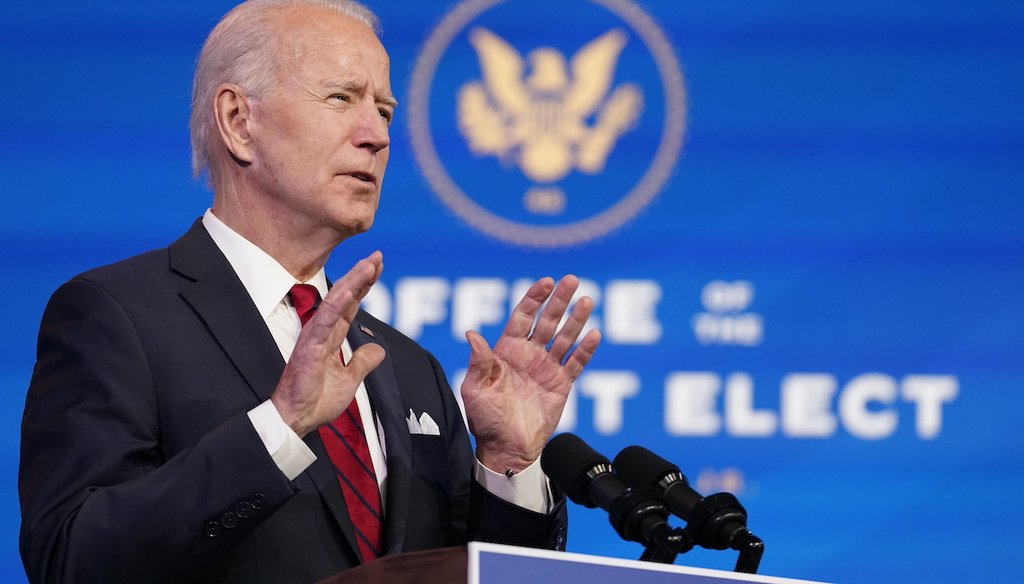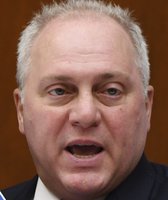Stand up for the facts!
Our only agenda is to publish the truth so you can be an informed participant in democracy.
We need your help.
I would like to contribute

President-elect Joe Biden speaks Jan. 15, 2021, in Wilmington, Del. (AP)
If Your Time is short
- President-elect Joe Biden laid out a $1.9 trillion dollar plan Thursday night to address what he’s calling the “twin crises” of the COVID-19 pandemic and the economy.
- He proposed that Congress allocate funds for implementing a national vaccination program, reopening schools, sending $1,400 checks to Americans who need them, increasing subsidies for Affordable Care Act insurance coverage and providing more assistance for housing, nutrition and child care, among other things.
- He also made several claims regarding how he believes the current response to the COVID-19 pandemic has been going and how it’s affecting Americans. His facts were mostly accurate.
President-elect Joe Biden laid out a $1.9 trillion dollar plan Thursday night to address what he’s calling the "twin crises" of the COVID-19 pandemic and the economy.
Biden proposed that Congress allocate funds for implementing a national vaccination program, reopening schools, sending $1,400 checks to Americans who need them, providing support for small businesses and extending unemployment insurance. He also proposed raising the minimum wage, increasing subsidies for Affordable Care Act insurance coverage, and providing more assistance for housing, nutrition and child care.
The plan is ambitious and will likely face some pushback in Congress. (Read PolitiFact’s analysis here.)
During his speech outlining what he’s dubbed the "American Rescue Plan," Biden made several claims regarding how he believes the current response to the COVID-19 pandemic has been going and how it’s affecting Americans. We fact-checked and gave context to a couple of the president-elect’s statements.
The vaccine rollout is far short of what officials promised it would be. According to a Centers for Disease Control and Prevention tracker, since mid-December, when vaccines first started being distributed, about 30 million doses of the vaccine have been sent out. But only about 11 million doses have actually been administered into the arms of Americans. The Department of Health and Human Services had initially issued a goal of administering 20 million doses by the end of December. That goal wasn’t reached.
A key reason for the slow pace, experts said, is that many state and local health departments lack the funding and resources to execute such a mass vaccination campaign. Communication with the federal government has also been dicey. Many states have complained that they aren’t informed about how much vaccine they are receiving and when — making logistical planning difficult. In addition, the outgoing Trump administration recently changed its recommendations for who should qualify, adding an additional layer of confusion for states.
Still, public health experts say that part of the reason the initial rollout was slow was because it occurred during the December holidays when many locations were understaffed. And since Congress approved a second COVID-19 stimulus bill, states will be receiving about $3 billion in funding relatively soon, which will help efforts.
This is accurate. Estimates vary on the exact number of Americans who live in households that are food insecure, but Biden’s numbers match recent numbers from the Census Bureau. The numbers translate to about 14% of all households and 20% of Black and Latino households.
The Census Bureau estimates food insecurity throughout the pandemic in a weekly report. According to numbers from December, 14% of all adults in the country reported their households sometimes or often not having enough food to eat in the last seven days. The data from December also shows that 24% of Black households and 21% of Latino households did not have enough food to eat.
A Northwestern University study estimates that at one point during the pandemic, nearly 23% of households in the U.S. experienced food insecurity.
"These crises are straining the budgets of states and cities and tribal communities that are forced to consider layoff and service restrictions of the most needed workers."
This is accurate. State and local governments generally by law are required to balance their operating budgets, resulting in some layoffs and reductions in services — though federal aid provided through COVID-19 relief helped. Late last year, the Brookings Institution projected state and local revenues would decline by $155 billion in 2020 and $167 billion in 2021. According to a report by the Center on Budget and Policy Priorities, states and localities have furloughed or laid off 1.2 million workers through October 2020. Brookings also noted that, because state and local governments "are at the forefront of the response to the pandemic" they "will likely need to increase their typical spending to provide crucial public health services and help communities adapt to social distancing guidelines."
Additionally, news reports starting early last summer detail a high number of health care workers being laid off or losing their jobs during the pandemic. Public health workers have also been furloughed or had their hours cut, despite having to create COVID-19 testing sites, initiate contact tracing programs and now create mass vaccination campaigns.
This is a softened version of a previous claim about laid-off "teachers" that we rated Mostly False. This number likely refers to Bureau of Labor Statistics data that shows the number of local government education jobs declined from March and October 2020 by 666,000.
But, that number doesn’t refer only to layoffs. Rather, it notes a net decrease in jobs. Reports show that during the pandemic, some educators have quit, retired or taken a leave of absence.
It’s also not clear what type of educators Biden is referring to, and though the BLS does track layoff data by industry, it lumps state and local education data together, which means that public college staff numbers are included. The BLS data shows that from March to October 39,000 state and local educators were laid off or discharged.
Our Sources
Associated Press, "Teacher departures leave schools scrambling for substitutes," Sept. 13, 2020
Becker’s Hospital Review, "Record number of healthcare workers laid off, furloughed during pandemic," June 5, 2020
The Brookings Institution, "How much is COVID-19 hurting state and local revenues," Sept. 24, 2020
Bureau of Labor Statistics, "Employment, Hours, and Earnings from the Current Employment Statistics survey (National)," accessed Jan. 15, 2021
Bureau of Labor Statistics, "Job Openings and Labor Turnover Survey," accessed Jan. 15, 2021
Centers for Disease Control and Prevention, COVID Data Tracker – Vaccinations, Accessed Jan. 15, 2021
Center on Budget and Policy Priorities, "Tracking the COVID-19 Recession’s Effect on Food, Housing and Employment Hardships," Jan. 8, 2021
Center on Budget and Policy Priorities, "Pandemic’s Impact on State Revenues Less Than Earlier Expected But Still Severe," Oct. 30, 2020
Census Bureau, Household Pulse Survey Data Tables, Accessed Jan. 15, 2021
Kaiser Health News and Associated Press, "Hollowed-Out Public Health System Faces More Cuts Amid Virus," July 1, 2020
Northwestern University, "How Much Has Food Insecurity Risen? Evidence from the Census Household Pulse Survey," June 10, 2020
NPR, "As Hospitals Lose Revenue, More Than A Million Health Care Workers Lose Jobs," May 8, 2020
Politifact, "Biden mischaracterizes teacher layoffs from pandemic," Nov. 20, 2020
Rev.com, "Joe Biden Speech Transcript on COVID-19 Economic Recovery Plan," Accessed Jan. 15, 2021




































